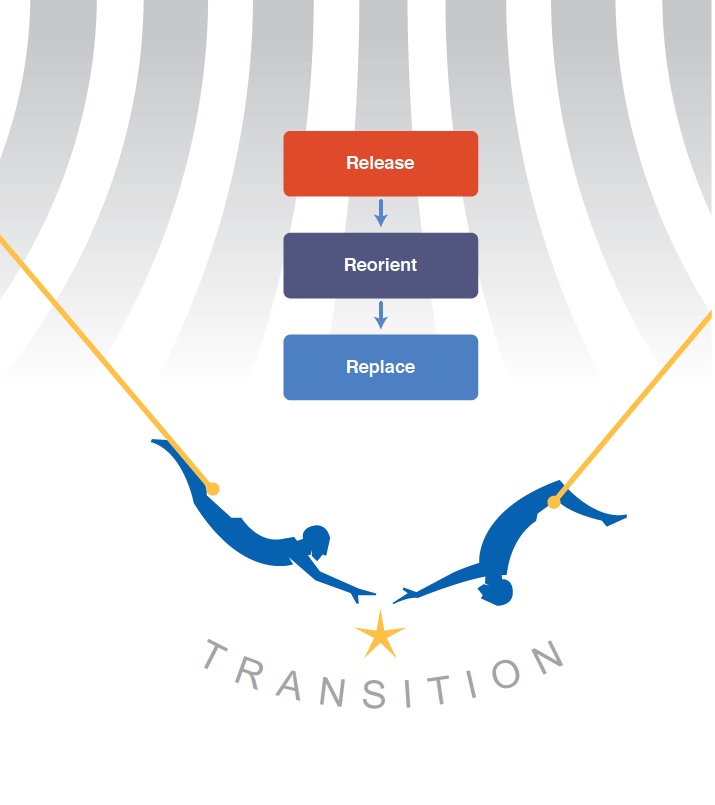Do you know the difference between change and transition?
Change is situational—it involves changing from one situation or context to another. For example, I change how I invoice customers; I use new software; I relocate to another home or office. Change is behavioral. You can get people to change their behavior and hold them accountable by observing performance and tangible results, but you cannot make them internalize the change. You must allow time and support to help them go through the emotions involved in transitioning toward the new situation.
Transition is mindset and attitude—a transition occurs when the emotions catch up to the situation: the new way of invoicing makes me feel less confident, fearful, or uncomfortable; the new software makes me feel uncertain or anxious; or the new location makes me feel sentimental and more nostalgic for the old location—a sense of loss. Transition is psychological. Transition can be described as a psychological process that allows people to come to terms with situational changes.
Insights on the Nature of Transition
Let’s now explore the nature of transition—and discover the five insights that naturally come with it.
- Transition is not optional. Everyone who changes from one situation or context to another must make the transition. If you don’t make the transition, you don’t transform.
- Transition is psychological. Again, most of the resistance you feel during this time is caused by emotions catching up to reality. So make sure you put on your game eyes, look through the trees, and see the root issues. For example, the immigration conflict at the U.S. border is an emotional issue; leaders have to consider the emotional elements to create an appropriate range of options.
- Transition is chaotic. Don’t plan on everything going exactly as planned! In transformations, you have to learn to deal with ambiguity. So, be flexible, and adapt while you are simultaneously helping others work through it. And if you didn’t plan for resources to cover the chaos, you have to be resourceful.
- Transition is painful. It will not be easy because it is about internalizing the changes and dealing with a loss! To transition, you always have to give up something. If you go into it thinking you will not experience any pain, you will have a strategy that backfires, and you will make the transition even more painful and drawn out.
- Transition surfaces hidden agendas. People you thought were on your side earlier may suddenly and surprisingly turn against you and the vision, especially when the transition begins to affect their personal space or when they feel incompetent in the new, demanding situation. This attitude shows up in those people who have the mental mindset of “my position is my identity.”
Think of a major change (a situation like a divorce, a move to a new city, or a change in careers) that you have experienced in your personal or professional life. Note the psychological elements involved in the transition and the emotions you had to grapple with to complete the transformational change. In transition, you may experience such emotions as anger, anxiety, fear, grief, loss, uncertainty, confusion, loneliness, regret, overreaction, or excitement. These are natural emotional responses that go along with the transition.
Three Major Phases of Transition

- Release. You “end” your dependence on the old swing when you let go of the swing (Oldland). Up to this point and until letting go, there is much anxiety, fear, and anger. Now you have to choose what to give up. For example, you may finish your relationship with school or need to let go of an ineffective leadership style, like perfectionism. And if you don’t release, you will always return—all the way back to Oldland.
- Reorient. This phase is where you are suspended in space and vulnerable. There can be uncertainty and a sense of losing control, being in a state of limbo and ambiguity (Transition Valley). To complete any transition, no matter what you feel you may gain, you always have to lose something. And with loss comes grief. So, you have to reorient yourself and internalize the reality that you cannot go back.
William Bridges, Ph.D., the preeminent authority on change and transition and author of Managing Transitions, calls this the “neutral zone” and explains: “Welcome to the middle phase of the transition process . . . it is the neutral zone because it is a nowhere between two somewheres, and because while you are in it, forward motion seems to stop a while and you hang suspended between was and will be. All the old clarities break down, and everything is in flux. Things are up in the air. Nothing is a given anymore, and anything could happen. No one knows the answers: one person says one thing, and someone else says something completely different.”
- Replace. This phase replaces the old swing with the new, leaves the past, and grasps the future (Newland). You cannot go back now. This space is the new beginning, and at this point, transformation takes place! The butterfly has emerged, never again to be a caterpillar.
You see, these three phases can help you lead your team through the transition. You see that people need some space and time to work through the phases of transition. They may have left Oldland physically but may still be catching up mentally or emotionally. Some never catch up, and it is usually in transition that some who started the journey may not make it to Newland.
Upside of Transition
Our transition begins the moment we let go of the last vestiges of Oldland and reach out a hand to grasp Newland and feel in that moment a bit of fear, uncertainty, or terror. Do we remain in a state of limbo or thrust forward and take that leap of faith into Newland?
The most disorienting thing about transition is that it begins with an end and ends with a beginning! It helps to have a keen awareness of what is going on and why a successful transition requires a specific strategy. Although there may be a feeling of adventure or excitement in transition, there are also undercurrents of anxiety or fear.
Transition is much like a rite of passage—you need to experience it to earn the right to enter Newland. This experience includes opportunities or benefits along with dangers or threats.
What benefits or opportunities does transition provide? Transition is the best time to . . .
- Make major changes during the discomfort before you settle into Newland.
- Identify influential leaders, as real leaders tend to surface during the trauma of transition. Now is the ideal opportunity to identify the next generation of leaders who will be needed in Newland.
- Maximize creativity and innovation. In transition, the group must think creatively and develop innovative ways of spreading the vision, strategizing, and solving problems. They are in lateral thinking mode. So, tackle new challenges and take advantage of the creative energy.
- Refocus on the vision. It is easy to lose sight of the vision during the journey and become caught up with minor problems. At this point, the vision needs to be revisited and reinforced before you cross the border into Newland. Hold people accountable for aligning with priorities.
- Reorganize structure and people. When the group reaches transition, it may be apparent that previous plans for the border crossing won’t work. Now is the time to rethink those plans.
- Confront or replace those resisting the change. Even at this late point, some people who like to control and resist are adamant that they do not want to change. Have the courage to confront them with an ultimatum–or remove them.
Downside of Transition
As with the upsides of transition, you will find more transformational change initiatives fail during a transition. Let’s think about why:
- The group has already been through visioning, strategizing, and navigating. When they reach transition, they relax, feel almost there, and begin to slide back to Oldland. They neither removed the anchor holding them to Oldland nor positioned it to pull them into Newland.
- The group is tired. Navigating the terrain is hard work. Although you need to celebrate the arrival in Transition, if you relax there, you will slip back.
- Management sees that the group is beginning to resist the change and tries to push them through Transition. Pushing (not pulling) provokes an immediate negative reaction that can destroy the change initiative. Here you have to manage the chaos without micromanaging the people by focusing on pulling rather than pushing.
- The group thinks they have finished. They have made plan after plan, sat in endless strategy meetings, and now think: “We’ve done all the planning, so the work is finished.”
Transformational change initiatives can fail in transition for other reasons. Transition is an exciting yet dangerous place to be on your journey to Newland. We either release our dependence on Oldland or return to Oldland. All who embark on this journey must be aware of the common dangers to take the final complex steps into Newland.
>>Read Part 2: How to Keep Momentum Up with People for Successful Transitions
For effective ways to navigate change, transitions, or create transformational leadership in your organization, contact us at J2NGlobal.com. Find out how we can help you.
Bill Poole is CEO of J2N Global and author of Journey to Newland.








